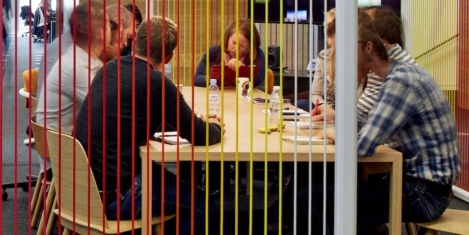December 15, 2025
December 2, 2025
Flexible working continues to be the enduring theme of workplace conversations
by Neil Franklin • Flexible working, News, Wellbeing
 Economic uncertainty and rapid technological change are reshaping expectations for both employers and employees, with flexible working continuing to be underlying theme of most workplace conversations. According to the 2025 Global Workplace Report from WorkL based on feedback from more than half a million employees across over one hundred countries, there are also widening divides between generations, differing attitudes towards career ambition and a continued rise in anxiety linked to automation. (more…)
Economic uncertainty and rapid technological change are reshaping expectations for both employers and employees, with flexible working continuing to be underlying theme of most workplace conversations. According to the 2025 Global Workplace Report from WorkL based on feedback from more than half a million employees across over one hundred countries, there are also widening divides between generations, differing attitudes towards career ambition and a continued rise in anxiety linked to automation. (more…)
November 28, 2025
Time to admit we were wrong about Canary Wharf and other business districts
by Mark Eltringham • Features, Flexible working, Property
 There was a time during and after the pandemic when it looked like time was up for the world’s major business districts. For a start Canary Wharf looked like it would need to completely reinvent itself as firms started to relocate to smaller more central premises. Instead of housing tenants such as HSBC it would focus on becoming a mixed-use space with more homes and leisure facilities. Hell, we even published a feature setting that all out ourselves. But it’s funny how things turn out. The latest news is JP Morgan’s announcement of a vast new headquarters building in the area. The bank, already one of the largest employers in the UK financial sector, has confirmed plans for a three million sq ft tower on the waterfront that will accommodate 12,000 staff and represent an investment estimated at £3 billion. (more…)
There was a time during and after the pandemic when it looked like time was up for the world’s major business districts. For a start Canary Wharf looked like it would need to completely reinvent itself as firms started to relocate to smaller more central premises. Instead of housing tenants such as HSBC it would focus on becoming a mixed-use space with more homes and leisure facilities. Hell, we even published a feature setting that all out ourselves. But it’s funny how things turn out. The latest news is JP Morgan’s announcement of a vast new headquarters building in the area. The bank, already one of the largest employers in the UK financial sector, has confirmed plans for a three million sq ft tower on the waterfront that will accommodate 12,000 staff and represent an investment estimated at £3 billion. (more…)
November 25, 2025
Canary Wharf travel numbers return to pre pandemic levels
by Neil Franklin • Flexible working, News, Property
 New figures suggest a sustained return to office working in London’s major business district, with Tube and rail journeys to Canary Wharf reaching their highest levels since before the pandemic. An analysis of Transport for London data indicates that an average of 91,000 daily journeys were made to the district’s stations in October on the Underground, Elizabeth Line and Docklands Light Railway. The total exceeded the equivalent month in 2019 and outpaced the recovery seen in the City and West End, where employers in sectors such as media and technology have been slower to insist on full time office attendance. (more…)
New figures suggest a sustained return to office working in London’s major business district, with Tube and rail journeys to Canary Wharf reaching their highest levels since before the pandemic. An analysis of Transport for London data indicates that an average of 91,000 daily journeys were made to the district’s stations in October on the Underground, Elizabeth Line and Docklands Light Railway. The total exceeded the equivalent month in 2019 and outpaced the recovery seen in the City and West End, where employers in sectors such as media and technology have been slower to insist on full time office attendance. (more…)
November 13, 2025
Lords Committee calls for clearer policy to address the future of home working
by Neil Franklin • Flexible working, News
 A House of Lords committee has called for a more coherent national approach to remote and hybrid work, warning that unclear responsibilities, inconsistent data, gaps in employer guidance and uneven access to flexible work risk undermining the UK’s ability to adapt to long-term changes in working patterns. According to the report, Is Working From Home Working?, published today (13 November) the rapid rise in home-based working since the pandemic has outpaced the Government’s ability to coordinate policy or collect reliable data. Responsibility for remote work is “split across government departments”, the Committee notes, with implications for employment, transport, digital infrastructure and housing policy. (more…)
A House of Lords committee has called for a more coherent national approach to remote and hybrid work, warning that unclear responsibilities, inconsistent data, gaps in employer guidance and uneven access to flexible work risk undermining the UK’s ability to adapt to long-term changes in working patterns. According to the report, Is Working From Home Working?, published today (13 November) the rapid rise in home-based working since the pandemic has outpaced the Government’s ability to coordinate policy or collect reliable data. Responsibility for remote work is “split across government departments”, the Committee notes, with implications for employment, transport, digital infrastructure and housing policy. (more…)
October 15, 2025
The evolving workplace in the hybrid working era
by Brad Hintze • Company news, Flexible working, Technology
 A little over five years ago, most knowledge workers went home — and dialed into the office remotely. The pandemic triggered a massive uptick in the “virtual workforce,” and organizations raced to provide technology to make connectivity possible. The limitations of those early “quick and dirty” solutions became apparent as the majority of the workforce settled into a hybrid model. (According to Gallup, 51 percent of US workers with remote-capable jobs follow a hybrid schedule while 28 percent are fully remote.) (more…)
A little over five years ago, most knowledge workers went home — and dialed into the office remotely. The pandemic triggered a massive uptick in the “virtual workforce,” and organizations raced to provide technology to make connectivity possible. The limitations of those early “quick and dirty” solutions became apparent as the majority of the workforce settled into a hybrid model. (According to Gallup, 51 percent of US workers with remote-capable jobs follow a hybrid schedule while 28 percent are fully remote.) (more…)
September 30, 2025
Service charges rise as firms invest to encourage people to spend more time in the office
by Neil Franklin • Flexible working, News, Property
 Office occupiers faced a 9 percent increase in service charges last year as landlords and managing agents invested more heavily in maintenance and amenities to encourage people back into physical workplaces. The findings come from BDO’s latest PropCost benchmarking report, which tracks more than £600 million of expenditure across over 1,000 commercial properties. The data shows the average cost increase for offices followed a 15 percent rise the previous year, underlining the pressure on both landlords and tenants from higher running costs. (more…)
Office occupiers faced a 9 percent increase in service charges last year as landlords and managing agents invested more heavily in maintenance and amenities to encourage people back into physical workplaces. The findings come from BDO’s latest PropCost benchmarking report, which tracks more than £600 million of expenditure across over 1,000 commercial properties. The data shows the average cost increase for offices followed a 15 percent rise the previous year, underlining the pressure on both landlords and tenants from higher running costs. (more…)
September 30, 2025
Mandates fail to bring people back to the office, but design and flexibility might
by Neil Franklin • Flexible working, News, Workplace design
 Rigid return-to-office mandates are doing little to increase attendance, according to new research from international design practice Hassell. The firm’s latest Workplace Futures Survey, titled The Mandate Mirage, suggests that the real motivator for people to work in person is choice, particularly when supported by offices designed to offer more than just a desk. The sixth edition of the survey, which polled 3,000 office workers across the UK, US, Australia, Singapore, Hong Kong and South Korea, finds that strict policies are more likely to generate dissatisfaction than compliance. In the UK, poorly executed mandates cut compliance by up to 41 percent, while organisations that offered bonuses or travel subsidies saw attendance increase by a third. Recently renovated offices also boosted in-person working by 15 percent. (more…)
Rigid return-to-office mandates are doing little to increase attendance, according to new research from international design practice Hassell. The firm’s latest Workplace Futures Survey, titled The Mandate Mirage, suggests that the real motivator for people to work in person is choice, particularly when supported by offices designed to offer more than just a desk. The sixth edition of the survey, which polled 3,000 office workers across the UK, US, Australia, Singapore, Hong Kong and South Korea, finds that strict policies are more likely to generate dissatisfaction than compliance. In the UK, poorly executed mandates cut compliance by up to 41 percent, while organisations that offered bonuses or travel subsidies saw attendance increase by a third. Recently renovated offices also boosted in-person working by 15 percent. (more…)
September 23, 2025
Hybrid working is now more about when work is done, rather than where
by Neil Franklin • Flexible working, News
![]() A new report from Owl Labs suggests that the debate over where people work is being replaced by questions about when they work. The firm’s 2025 State of Hybrid Work report argues that the defining issue in workplace flexibility and hybrid working is now time rather than location. The study, based on a survey of 2,000 US workers, claims that almost half of respondents believe they do not have enough flexibility in their working hours. Thirty seven percent said they would turn down a job that did not provide flexible scheduling, an increase compared to last year. Around a quarter said they would find a four day week more attractive than a traditional arrangement, with many indicating they would be willing to take a pay cut in exchange for greater control over their time. On average, workers said they would give up around eight to nine percent of their salary to secure more flexible hours or a reduced working week. (more…)
A new report from Owl Labs suggests that the debate over where people work is being replaced by questions about when they work. The firm’s 2025 State of Hybrid Work report argues that the defining issue in workplace flexibility and hybrid working is now time rather than location. The study, based on a survey of 2,000 US workers, claims that almost half of respondents believe they do not have enough flexibility in their working hours. Thirty seven percent said they would turn down a job that did not provide flexible scheduling, an increase compared to last year. Around a quarter said they would find a four day week more attractive than a traditional arrangement, with many indicating they would be willing to take a pay cut in exchange for greater control over their time. On average, workers said they would give up around eight to nine percent of their salary to secure more flexible hours or a reduced working week. (more…)
September 18, 2025
Flexible working policies have only a limited effect on how people actually work
by Neil Franklin • Flexible working, News, Wellbeing
 A major UK policy reform to expand workers’ rights to request flexible working has not substantially changed how people work in practice, according to new research from King’s Business School, UCL and City, University of London. The study analysed data from more than 15,000 employees in the UK Household Longitudinal Study spanning 2010 to 2020, focusing in particular on the 2014 policy that extended the legal right to request flexible working to all employees with at least 26 weeks’ service, rather than just parents or carers. It found that while women are more likely to reduce their hours following the reform, there was no corresponding increase in remote working or flexitime among either men or women. (more…)
A major UK policy reform to expand workers’ rights to request flexible working has not substantially changed how people work in practice, according to new research from King’s Business School, UCL and City, University of London. The study analysed data from more than 15,000 employees in the UK Household Longitudinal Study spanning 2010 to 2020, focusing in particular on the 2014 policy that extended the legal right to request flexible working to all employees with at least 26 weeks’ service, rather than just parents or carers. It found that while women are more likely to reduce their hours following the reform, there was no corresponding increase in remote working or flexitime among either men or women. (more…)
September 16, 2025
Employees on a four-day week use their extra day off for housework, hobbies, ‘me-time’ and moonlighting
by Neil Franklin • Flexible working, News, Workplace
 New research claims to shed light on how employees who switch to a four-day week spend their additional day off – and some are using it to take on extra jobs. As well as housework, hobbies and voluntary work, staff are also devoting time to education, caring responsibilities and side businesses that can sometimes compete with their main employment. The study, led by Dr Mengyi Xu, Dr Daniel Wheatley, Dr Holly Birkett and Professor Tony Dobbins of Birmingham Business School at the University of Birmingham, explored the experiences of employees, managers and executives at UK organisations using the ‘100:80:100 model’, where staff receive 100 percent of their pay while completing their workload in four days rather than five. (more…)
New research claims to shed light on how employees who switch to a four-day week spend their additional day off – and some are using it to take on extra jobs. As well as housework, hobbies and voluntary work, staff are also devoting time to education, caring responsibilities and side businesses that can sometimes compete with their main employment. The study, led by Dr Mengyi Xu, Dr Daniel Wheatley, Dr Holly Birkett and Professor Tony Dobbins of Birmingham Business School at the University of Birmingham, explored the experiences of employees, managers and executives at UK organisations using the ‘100:80:100 model’, where staff receive 100 percent of their pay while completing their workload in four days rather than five. (more…)
September 11, 2025
Return to office policies now more common, but raise people’s expectation of better workplaces
by Neil Franklin • Flexible working, News, Property, Workplace
 The news that Microsoft has introduced a formal hybrid working policy has sparked the usual pointless to and fro on social media about return to office policies, but it would seem for a growing number of firms and their employees, the debate is over. According to new global research from JLL, 72 percent of employees now view attendance requirements in a positive light, but this shift comes with heightened expectations for workplace quality, flexibility and wellbeing. (more…)
The news that Microsoft has introduced a formal hybrid working policy has sparked the usual pointless to and fro on social media about return to office policies, but it would seem for a growing number of firms and their employees, the debate is over. According to new global research from JLL, 72 percent of employees now view attendance requirements in a positive light, but this shift comes with heightened expectations for workplace quality, flexibility and wellbeing. (more…)























